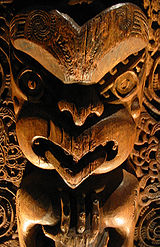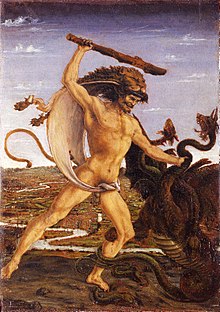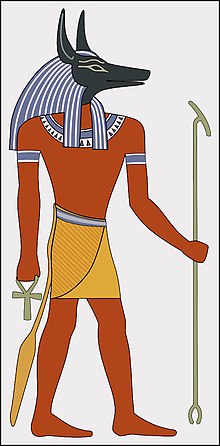6.4: Concepts of Supernatural Beings
- Page ID
- 5319
There are many different ways cultures conceptualize their spiritual beings. These include, but are not limited to: Animatism, Animism, Anthropomorphism, Dualism, Euhemerism, Totemism, and Zoomorphism.
Animatism


Animatism is the belief in a supernatural power that is able to be something other than a person or animal. In this sense, it is the belief that the supernatural is all around you and could be anything. Individuals that hold these beliefs explain a powerful unseen force that can potentially be found all around us; in people, animals, plants and features of nature such as volcanoes and the ocean, for example, Mother Earth (believing in the non-living). The belief of animatism doesn't assign a spiritual identity but instead believes in a single unified power that can manifest itself into objects or be acquired by and controlled by certain individuals. The term was coined by the British Anthropologist Robert Ranulph Marett as "a belief in a generalized, impersonal power over which people have some measure of control" Animatism is the cause of consciousness and personality to natural phenomena such as thunderstorms and earthquakes and to objects such as plants and stones. Inanimate objects, forces, and plants have personalities and wills, but not souls. These forces are inanimate and impersonal, This is not true for those beliefs relating to animism. In the South Pacific Polynesian cultures, the power of animatism is commonly referred to as "Mana". For them, it is a force that is inherent in all objects, plants, and animals (including people) to different degrees. Some things or people have more of it than others and are therefore, potentially dangerous. Often a chief must have some with him at all times. Dangerous places, such as volcanoes, were considered to have concentrated amounts of mana. Mana is a spiritual quality considered to have supernatural origin – a sacred impersonal force existing in the universe. Therefore to have mana is to have influence and authority, and efficacy – the power to perform in a given situation. Mana, Marett states, is a concentrated form of animatistic force found within any of these objects that confer power, strength, and success. For example, the Polynesians, believe in mana as a force inherent in all objects. This essential quality of mana is not limited to persons – folks, governments, places and inanimate objects can possess mana.
Animism
Animism is one of the oldest beliefs, dating back to the Paleolithic age (a prehistoric period distinguished by the earliest known primitive tools about 2.5 million to 40,000 years ago). It is greatly associated with primitive peoples, those without a written tradition. Animism believes that natural objects, natural phenomena, and the universe all possess individual souls. It is derived from the Latin word anima, meaning a breath or soul. Sir Edward Burnett Tylor was one of the first Anthropologists to study animism, believing it to be a “minimum definition of religion”, he theorized that all globally recognized religions had some aspects of animism. Tylor posted that animism was birthed by primitive cultures mistaking their dreams for reality.[2] It is believed that animism was first constructed out of a need to explain natural phenomena such as sleeping, dreaming, and death. In classical animism, it is said that spirits are a separate entity from the body, and cause life in humans by passing through bodies and other inanimate objects. Robert Ranulph Marett, another Anthropologist of Tylor’s time, suggested that the earliest forms of animism were created based on emotion and intuition, rather than sacred practices, and written word. He believed that the earliest animists based their religion on inanimate objects acting strangely, or uniquely giving them the illusion of life alike to humans, trees blowing in the wind for instance. Contrary to Tylor, Marett believed that animists did not separate between the body and the soul, claiming them to be a single entity living and dying as one.
In terms of practices, many animistic cultures worshiped plant life, including trees and plants, because of their beauty, strength, and life. It is thought that all beings, including plants, have a soul. This is why in many Native American cultures totem poles are a major symbolic structure, and the main focus of many rituals. Centuries ago the Coast Salish Indian Tribe was well known for its belief in spiritual transmutation between humans and animals, a trait of animistic culture. Living in Cowichan Valley, on Vancouver Island they created hundreds of totem poles in order to showcase the spirits believed to be living in the animals portrayed upon the totems, and the trees the totems themselves were made out of. Now, the remnants of these totems are on display in both museums, and in their original locations in the city of Duncan, now known as “Totem City” because of the animistic art left over by the Coast Salish Indians.

As mentioned, animism is greatly associated with more primitive cultures. However, “new animism” a more symbolic and less literal form of animism is still found in many different cultures worldwide^ . This form of the religion is focused on the different types of souls in different types of people from all different cultures. It is more acutely understood as the teaching of how to have respectful relationships with human beings, as well as the natural world. It is also to be understood, that not all things have a truly human soul, including humans, and part of animism is distinguishing what/who is truly human, and what/who is not. The basic idea is that showing respect for relationships is vital to survival.
Anthropomorphism
Anthropomorphism is the concept of attributing human characteristics or behaviors to a non-human being. This can mean animals, plants, and almost anything else taking on the personality of a human. It can mean that any object can be given human traits by a person, such as a dog feeling guilty for stealing food, or the gurgling of a stream sounding happy. Different religions have different interpretations of anthropomorphism, but in general, it is to show their God as something or someone else. In Greek mythology anthropomorphic animals are representations of their Gods. The Greeks show that the gods are different from us by attributing them to the features of being ‘immortal and ageless.’ [3]
In the anthropology of religion, the primary use of anthropomorphism is to embody the supernatural in human form. An example that is most defined in Western culture is in Judaism and Christianity, God has given human feelings of anger and jealousy or compassion and forgiveness. All human qualities that have been given to God in human settings that surround humanity, where these feelings are all emotions that humans have observed and none that we haven't. A functional analysis of anthropomorphism proposes that when the supernatural takes human form, it may be easier for people to relate to the concepts promoted by religion.
Dualism
The term dualism was originally coined to denote co-eternal binary opposition. A meaning that is preserved in metaphysical and philosophical duality discourse but has been more generalized in other usages to indicate a system which contains two essential parts. Bitheism/Ditheism are two forms that both involve the two gods. Bitheism implies that the gods live in peace and Ditheism implies that their in opposition. This means that a Ditheism system would have one good and one evil god or one god that listened and helped and one that ignored. A god of life and one of death is another example. An example of a Bitheism system would be something like one god is of the sky and one of the wind. It is not always easy to distinguish between the two, like a sky god who brings storms and rain and an earth god who brings fertility and tremors. In a moral sense Christianity is a dualism religion with the opposition of God and Satan.[3]
Euhemerism

Euhemerism is a rationalizing method of interpretation that was named after the Greek mythographer (compiler of myths) Euhemerus. Euhemerism is the idea that a real person can become a deity or a supernatural immortal being through the constant telling and re-telling of their stories that leads to the distortion of the actual story. For example, many people believe that Hercules was a real person but was deified through the stories of his life and after some time the embellished story became the accepted story. Therefore, Hercules was remembered as a deity. Euhemerism is the worship and belief in an ancestor or historical being who is thought to have supernatural power. Euhemerus believed that every Greek god was someone that actually lived long ago and was immortalized in myth through their actions in life.[4]
Totemism

Totemism is a religious practice in which a family is seen to have a close kinship with a particular spiritual being, such as an animal or plant. The entity, or totem, is thought to interact with a given kin group or an individual and to serve as their emblem or symbol.[4] Each spirit can be associated with an animal of some kind as a symbol of power or any other type of attribute. Masks are sometimes used as well to recreate the spirit or being. Usually seen through the use of Totem poles. with Native American families in traditional societies. Though this is usually seen in Native American traditional societies, this is something that is practiced all over the world. The term totem is derived from the Ojibwa word ototeman, meaning “one’s brother-sister kin.” The grammatical root, ote, signifies a blood relationship between brothers and sisters who have the same mother and who may not marry each other.[5]
Zoomorphism

Zoomorphism is the attribution of animal qualities or characteristics to a God. Many times it is mistaken for anthropomorphism, which attributes human characteristics or qualities to things that are not human. Zoomorphic supernaturals can be found in many religions, such as Hinduism with the deity Ganesha. Other examples include images of male deities with antlers that appeared in prehistoric art in countries as far apart as France, Australia, Canada, and China. [5]
An example of zoomorphism can also be found Egyptian mythology with the god Anubis. In Egyptian mythology, Anubis was the god that protected the dead and brought them to the afterlife until Osiris took over the position and then Anubis became the gatekeeper of the dead.[6] In Egyptian Mythology Anubis has the head of a jackal with the body of a human. His head is the color black because black is the color associated with death and the rotting color of flesh and the black soil of the Nile valley. The head of a jackal is significant because in ancient times jackals would hunt at the edges of deserts near the necropolis and cemeteries and ravage the desert graves throughout Egypt.[7] Anubis was not the only zoomorphic god of Egypt. Horus was often drawn as a falcon on the shoulder of a ruler and he is typically depicted as having the head of a falcon when drawn alone. He was often used to show a ruler's connection to the Gods. Other examples in Egyptian mythology include Hathor, who is often depicted as a cow, and the warrior goddess Sekhmet, who is depicted as a lioness in human form.[6]


